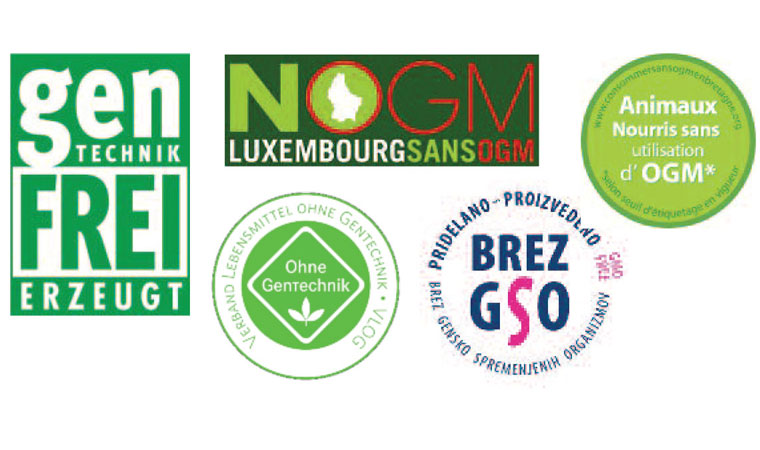With widespread rejection of genetically modified foods and mandatory labeling of such foods in the European Union, it would seem that labeling foods “non-GMO” would not be necessary. However, the EU imports millions of tons of GM soy for animal feed, and EU law does not require labeling of meat, dairy, and eggs derived from GM feed. As a result, a growing number of EU member states have established non-GMO or “fed without GMOs” labeling programs for animal-derived products. The labels allow meat and dairy producers to market their products as non-GMO to GMO-sensitive Europeans.
For example, Germany’s Ohne Genetechnik or “no genetic engineering” program was established in 2008 by the German government.
“It was industry players who felt it was necessary to establish a GMO-free labeling program,” says Jochen Koester, a board member of VLOG, a German industry association of food companies producing non-GMO products. “An increasing number of German consumers, around 80 percent in surveys, reject GMOs.”
VLOG has about 400 members. “All major food retailers are members and farmers and food manufacturers, including the EU’s largest poultry supplier,” Koester says.
There are more than 6,000 food products that bear the Ohne Gentechnik seal, and these generate sales of more than 4.4 billion euros.
Other EU countries that have non-GMO labeling programs include Austria, France, Luxembourg, Hungary, Slovenia, and Italy’s Tiro region. Similar programs are underway in Belgium, Croatia, Serbia, and Bosnia-Herzegovina.
Danube Soya’s harmonized non-GMO standard
With the growing number of non-GMO labeling programs, Danube Soya, an Austria-based organization that is encouraging production of non-GMO soy, led an initiative to harmonize the different programs in the Danube Region.
“It would be a nightmare to have a different labeling system for each country because it could create a trade barrier, and if you have different labels it would confuse consumers and be very impractical,” says Matthias Krön managing director of Danube Soya.
The aim was to develop a region-wide non-GMO standard that could later be expanded. “We thought this could be the basis for a European solution in the future,” Krön says.
Helmut Gaugitsch, who leads Austria’s Land Use & Biosafety department, served as project leader to develop the standard. The standard was developed by a technical working group and a review group comprising members of government agencies from 11 countries of the Danube Region.
Non-GMO is the cornerstone of the Danube Soya standard. “The standard is needed to clarify what is meant by GMO-free for food production,” Gaugitsch says.
Other “pillars” of the standard, according to Gaugitsch, are a regional focus, meaning that soybeans for feed should come from the Danube Region, and sustainability requirements such as reducing the use of pesticides.
The standard is based on labeling programs of Austria and Germany.
“The final standard is very similar to those of two systems with regard to definitions of non-GMO feed and food, (GMO) thresholds, conversion periods for feeding animals GM and non-GM substances, and associated control systems,” Gaugitsch says.
In order to make a non-GMO claim, products must not exceed a GMO threshold of 0.9 percent, which is the EU standard for GMO labeling. Also, Gaugitsch says that “every effort must be made to go below 0.9 percent.”
“We have to assure consumers that GMO contamination is as low as possible in their GMO-free food,” he says.
Countries implementing standard
The Danube Region nations are now implementing the standard, which is meant to be a guidance document that each country can adopt, according to its own needs.
“We are now working with ministries in different countries to get this standard to be adopted as a national standard in each country,” Krön says.
To date, Austria, Germany, Hungary, Slovenia, and Italy’s Tiro region have adopted the standard. According to Gaugitsch there is interest from Bosnia-Herzegovina, Serbia, Moldava, and Ukraine in establishing the standard.
The long-term goal is to have an EU-wide non-GMO labeling program.
“It’s very important because it supports production of non-GMO soy and non-GMO products in the EU,” Krön says. “It allows a common market for products. If you have a non-GMO product in one country then you can sell it as non-GMO in another.”








